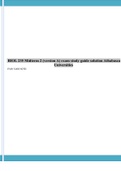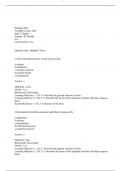Biol 235 chapter 5 - Study guides, Class notes & Summaries
Looking for the best study guides, study notes and summaries about Biol 235 chapter 5? On this page you'll find 37 study documents about Biol 235 chapter 5.
Page 3 out of 37 results
Sort by
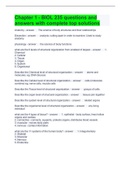
-
Chapter 1 - BIOL 235 questions and answers with complete top solutions
- Exam (elaborations) • 6 pages • 2023
-
Available in package deal
-
- $11.49
- + learn more
Chapter 1 - BIOL 235 questions and answers with complete top solutions Anatomy The science of body structures and their relationships Dissection analysis; cutting apart in order to examine. Used to study anatomy physiology the science of body functions what are the 6 levels of structural organization from smallest of largest. 1. Chemical 2. Cellular 3. Tissue 4. Organ 5. System 6. Organismal Describe the Chemical level of structural organization. atoms and ...
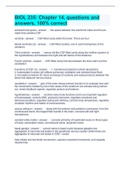
-
BIOL 235: Chapter 14, questions and answers, 100% correct
- Exam (elaborations) • 3 pages • 2023
-
Available in package deal
-
- $8.99
- + learn more
BIOL 235: Chapter 14, questions and answers, 100% correct subarachnoid space the space between the arachnoid mater and the pia mater that contains CSF ventricle CSF-filled cavity within the brain. There are four lateral ventricles (2) CSF-filled cavities; one in each hemisphere of the cerebrum Third ventricle narrow slit-like CSF-filled cavity along the midline superior to the hypothalamus and between the right and left halves of the thalamus Fourth ventricle CSF...
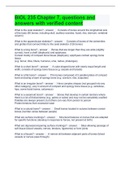
-
BIOL 235 Chapter 7, questions and answers with verified content
- Exam (elaborations) • 9 pages • 2023
-
Available in package deal
-
- $10.99
- + learn more
BIOL 235 Chapter 7, questions and answers with verified content What is the axial skeleton? Consists of bones around the longitudinal axis of the body (80 bones, including skull, auditory ossicles, hyoid, ribs, sternum, vertebral column) What is the appendicular skeleton? Consists of bones of the extremities and girdles that connect limbs to the axial skeleton (126 bones) What is a long bone? Bones that are longer than they are wide (slightly curved), have a shaft (diaphysis) a...
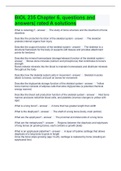
-
BIOL 235 Chapter 6, questions and answers| rated A solutions
- Exam (elaborations) • 6 pages • 2023
-
Available in package deal
-
- $10.99
- + learn more
BIOL 235 Chapter 6, questions and answers| rated A solutions What is osteology? The study of bone structure and the treatment of bone disorders Describe the protection function of the skeletal system The skeleton protects internal organs from injury Describe the support function of the skeletal system The skeleton is a structural framework for the body (it supports soft tissues and provides attachment points for tendons) Describe the mineral homeostasis (storage/release)...

-
BIOL 235 Chapter 8, questions and answers with rated solution
- Exam (elaborations) • 7 pages • 2023
-
Available in package deal
-
- $11.49
- + learn more
BIOL 235 Chapter 8, questions and answers with rated solution Describe the pectoral girdles Consist of clavicle and scapula (shoulders); attach bones of the upper limbs to the axial skeleton Girdles don't articulate with the vertebral column, they are held in position by a group of muscles Describe the clavicle Collarbone; S-shaped bones that lie horizontally across the anterior thorax (medial end is anteriorly convex) Sternal end: rounded medial end, articulates with manubrium of t...
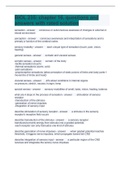
-
BIOL 235: chapter 16, questions and answers with rated solution
- Exam (elaborations) • 10 pages • 2023
-
Available in package deal
-
- $12.99
- + learn more
BIOL 235: chapter 16, questions and answers with rated solutions ensation consicous or subconscious awareess of changes in external or interal environment perception consicous awareness and interprtation of sensations and is primarly a function of the cerebral cortex sensory modality each unique type of sensation (touch, pain, vision, hearing) general senses somatic and visceral senses somatic senses somat= of the body -tactile sensation (touch) -thermal sensa...
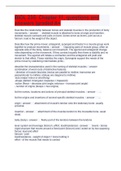
-
BIOL 235: Chapter 11, questions and answers |graded A+
- Exam (elaborations) • 8 pages • 2023
-
Available in package deal
-
- $11.99
- + learn more
BIOL 235: Chapter 11, questions and answers |graded A+ Describe the relationship between bones and skeletal muscles in the production of body movements. skeletal muscle is attached to bone at origin and insertion. skeletal muscle contracts and pulls on bone. bones serve as levers. joint act as a fulcrum. load is the weight of the object. Describe how the prime mover, antagonist, synergist and fixator in a muscle group work together to produce movements. Opposing pairs of muscle group, ...
BIOL 235/BIOL235-Chapter-5-Test Bank (PAP 15): Human Anatomy and Physiology: Biology (Athabasca University)
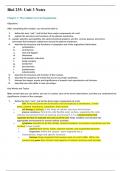
-
Biol 235- Unit 3 Notes Chapter 3: The Cellular Level of Organization
- Exam (elaborations) • 44 pages • 2023
-
- $9.99
- + learn more
Biol 235- Unit 3 Notes Chapter 3: The Cellular Level of Organization Objectives After completing this chapter, you should be able to 1. define the term “cell,” and list the three major components of a cell. 2. explain the structure and functions of the plasma membrane. 3. explain selective permeability, the electrochemical gradient, and the various passive and active processes that transport substances across the plasma membrane. 4. describe the structure and functions of cytopla...

Did you know that on average a seller on Stuvia earns $82 per month selling study resources? Hmm, hint, hint. Discover all about earning on Stuvia

